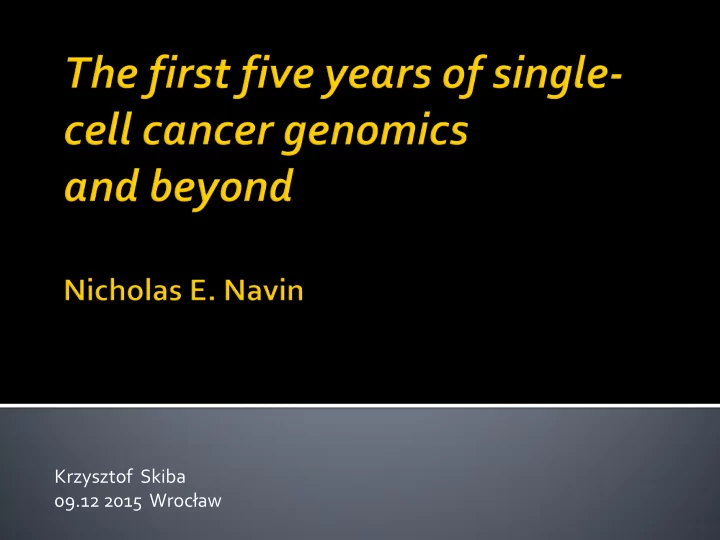

Krzysztof Skiba 09.12 2015 Wrocław
What is SCS? History of SCS Clonal diversity and evolution in primary tumors Circulating tumor cells and metastatic dissemination Delineating complex chromosome rearrangements in single cells Evolution of therapy resistance Mutator phenotypes SCS in animal models Translational applications of SCS in the clinic Technical challenges and emerging technologies Conclusions and future directions
Single cell sequencing NGS on single cells Huge impact on cancer research Differences to NGS? Single cell extraction WGA (whole genome amplification) before NGS (genomic input in ng ) Looped amplicons
Intratumor heterogeneity (phylogenetic lineages for cells in tumor mass) Clonal evolution: by SCS mostly CNVs in early tumor cells development SNPs accumulation over time Single cells share common founder mutations, suggesting evolution from a common origin
Cells that circulate in blood RARE (1 cel in 1 000 000) Carry ~60% SNPs from primary and metastatic tumors (prostate, lung, breast) Blood markers for tumors? (non invasive) CTCs express their own extracellular matrix proteins in the blood
Tumor evolution = chromosome structural rearrangments = gene dosage effects Evolution dynamics SCS represents cells at differnet evolution time CNA – copy number aberrations, early in tumor evolution Chromothripsis – within single chromosome
Initial response to therapy, but eventually resistance to treatment Epithelial-to-mesenchymal transition (EMT) Resistance clones preexisting (adaptive) Induced new mutations (acquired) SCS: Androgen gene amplification in CTCs (prostate cancer = adaptive resistance)
Human cancers = higher mutation rate ? Estimated mutation rate: 210 x normal cells SCS: 2.5 nucleotide error per cell division marginally higher then normal SCS: breast cancer – 13.3 x normal SCS limited to few patients – need more research
Genetically engineered mice (GEM) Xenografts SCS: transplantation of breast cancer from human to mouse1 -> mouse2 - >… mouseN. Selection of tumor cells and high mutation rate. RNA-SCS: pancreatic cancer, CTCs and fluorescent markers.
Phylogenetic trees -> therapeutic targets CTCs and cancer cells in bodily fluids -> early noninvasive detection SCS advantage -> very small clinical samples
Drop-seq (uses nanoliter droplets and barcoded beads to capture single cells and performWTA, enabling RNA-SCS on 10,000 – 100,000 cells in a single run ) https://vimeo.com/128484564
SCS improoved understanding of decelopment , heterogeneity, metastasis, invasion of tumor cells. SCS for gene expression analysis. SCS as a tool for connecting genotypes with phenotypes.
The first five years of single-cell cancer genomics and beyond Nicholas E. Navin, doi:10.1101/gr.191098.115Genome Res. 2015. 25:1499-1507 https://en.wikipedia.org/wiki/MALBAC
Recommend
More recommend